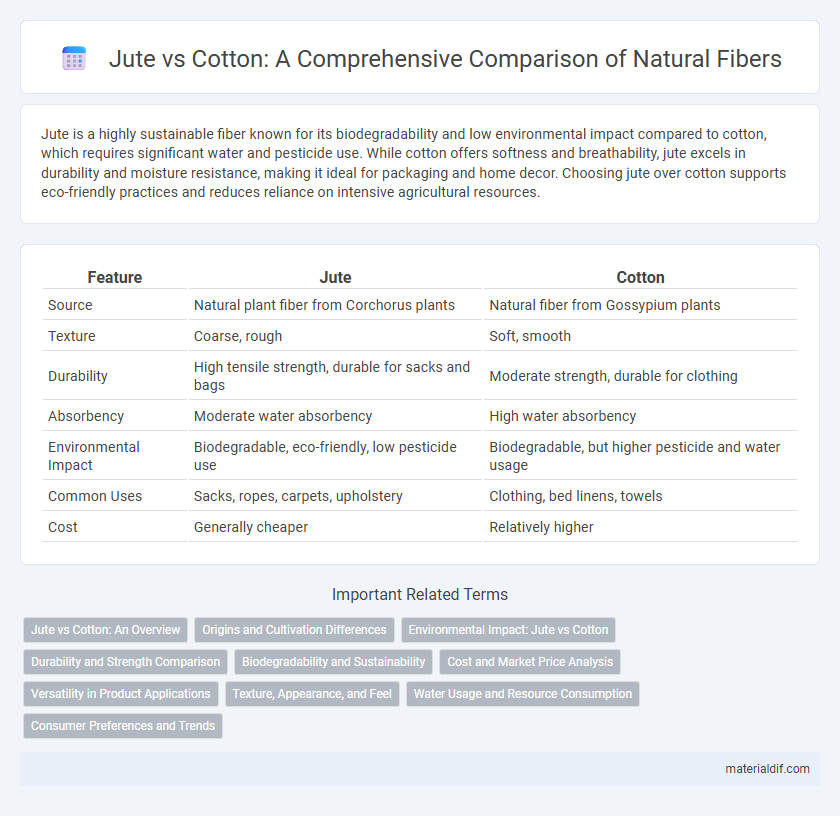Jute is a highly sustainable fiber known for its biodegradability and low environmental impact compared to cotton, which requires significant water and pesticide use. While cotton offers softness and breathability, jute excels in durability and moisture resistance, making it ideal for packaging and home decor. Choosing jute over cotton supports eco-friendly practices and reduces reliance on intensive agricultural resources.
Table of Comparison
| Feature | Jute | Cotton |
|---|---|---|
| Source | Natural plant fiber from Corchorus plants | Natural fiber from Gossypium plants |
| Texture | Coarse, rough | Soft, smooth |
| Durability | High tensile strength, durable for sacks and bags | Moderate strength, durable for clothing |
| Absorbency | Moderate water absorbency | High water absorbency |
| Environmental Impact | Biodegradable, eco-friendly, low pesticide use | Biodegradable, but higher pesticide and water usage |
| Common Uses | Sacks, ropes, carpets, upholstery | Clothing, bed linens, towels |
| Cost | Generally cheaper | Relatively higher |
Jute vs Cotton: An Overview
Jute and cotton are two natural fibers widely used in the textile industry, with jute known for its strong, coarse texture and cotton valued for its soft, breathable qualities. Jute fibers are primarily sourced from the Corchorus plant and are biodegradable, making jute an eco-friendly choice, whereas cotton is derived from the seed hairs of the Gossypium plant and often demands higher water usage in cultivation. The comparison highlights jute's durability and sustainability versus cotton's comfort and versatility in applications.
Origins and Cultivation Differences
Jute, primarily cultivated in Bangladesh and India, originates from the Corchorus plant, thriving in warm, humid climates with ample rainfall, whereas cotton grows in a wider range of climates, particularly in the USA, China, and India, from the Gossypium genus. Jute cultivation requires less pesticide and fertilizer compared to cotton, making it more environmentally sustainable. The longer growing period of jute, around 4-6 months, contrasts with cotton's 5-6 months, reflecting their differing agricultural practices and resource needs.
Environmental Impact: Jute vs Cotton
Jute cultivation requires significantly less water and fewer pesticides compared to cotton, making it a more sustainable fiber choice with a lower environmental footprint. Cotton farming often involves intensive irrigation and heavy chemical use, leading to soil degradation and water pollution. Jute's biodegradability and minimal agrochemical dependence contribute to reduced ecological damage and enhanced soil health.
Durability and Strength Comparison
Jute fibers exhibit superior tensile strength and durability compared to cotton, making them ideal for heavy-duty applications such as sacks, ropes, and mats. The high lignin content in jute contributes to its rigidity and resistance to wear, whereas cotton's softness and lower tensile strength limit its use in industrial contexts. Jute's robustness ensures longer lifespan and better performance under stress, distinguishing it from the more delicate cotton fibers.
Biodegradability and Sustainability
Jute is highly biodegradable, decomposing within a few months, making it an eco-friendly alternative to cotton, which can take years to break down due to chemical treatments. Cultivating jute requires significantly less water and fewer pesticides compared to cotton, enhancing its sustainability profile. Its natural fibers contribute to reduced environmental pollution and support sustainable agriculture practices.
Cost and Market Price Analysis
Jute is generally more cost-effective than cotton, with lower cultivation and processing expenses contributing to its affordability. Market price analysis reveals that jute prices tend to be more stable due to fewer fluctuations in global demand compared to cotton, which is heavily influenced by fashion trends and industrial use. This economic advantage makes jute a preferred raw material in the packaging and textile industries, especially in regions focused on sustainable production.
Versatility in Product Applications
Jute exhibits superior versatility compared to cotton, as it is widely used in products ranging from eco-friendly bags, mats, and rugs to composite materials and geotextiles. While cotton primarily serves the textile and apparel industries, jute's coarse fibers support diverse industrial applications including packaging, upholstery, and home decor. This adaptability enhances jute's value in sustainable manufacturing and green product innovations.
Texture, Appearance, and Feel
Jute fibers exhibit a coarse texture and a natural, earthy appearance, characterized by a rougher feel compared to cotton's smooth and soft surface. Cotton features a finer, more pliable texture that provides a comfortable touch ideal for garments and bedding. The glossy, golden hue of jute contrasts with cotton's matte, off-white color, influencing their distinct aesthetic applications in textiles and decor.
Water Usage and Resource Consumption
Jute cultivation requires significantly less water compared to cotton, using approximately 1000-1500 liters per kilogram versus cotton's 10,000-20,000 liters per kilogram. Jute also demands fewer chemical fertilizers and pesticides, reducing soil degradation and minimizing environmental impact. This lower resource consumption positions jute as a more sustainable fiber alternative in industries focused on water conservation and eco-friendly production.
Consumer Preferences and Trends
Consumers increasingly prefer jute over cotton due to its eco-friendly properties and biodegradability, aligning with growing sustainability trends. Jute's natural coarse texture appeals to environmentally conscious buyers seeking durable, reusable products, while cotton remains favored for softness and comfort in apparel. Market trends show rising demand for jute-based items in packaging and fashion, driven by regulatory shifts and a push toward reducing plastic use.
Jute vs Cotton Infographic

 materialdif.com
materialdif.com